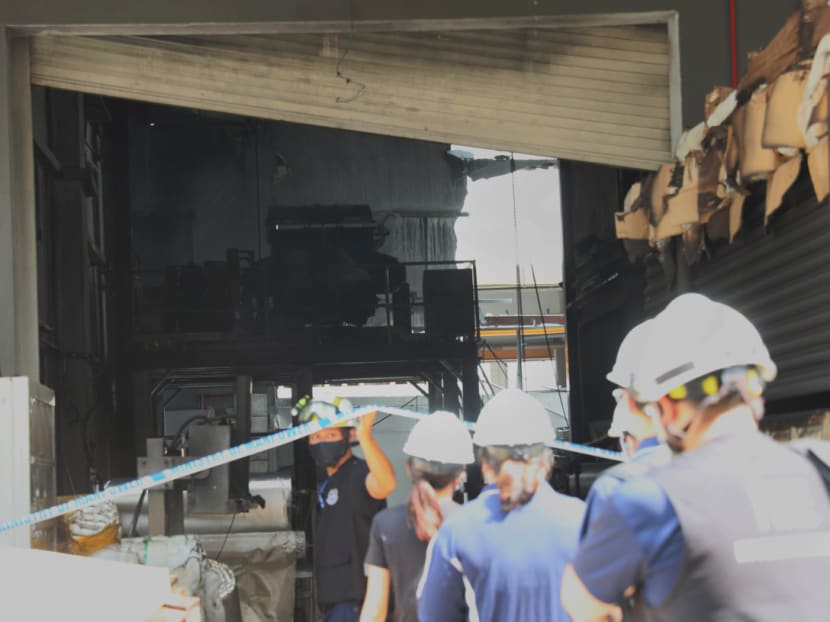Tuas deadly blast: Machine’s user guide is deficient but onus is on user to ask and deduce, expert says
SINGAPORE — A user guide on how to operate a mixer machine that ruptured and caused a deadly explosion at a Tuas industrial worksite did not properly spell out how it should be set up, an expert said on Thursday (Oct 7).

The workshop of Stars Engrg (pictured) on Feb 24, 2021, after an explosion and fire killed three workers.
- A mechanical engineering expert gave his views at an inquiry hearing into a deadly explosion at a Tuas worksite
- He said there are deficiencies in a machine’s user guide in explaining how it should be operated
- However, the onus is on the user to find out how the machine should be used if there are any doubts
- The user “must have an inquisitive mind and logical mind to deduce” when problems arise, he added
SINGAPORE — A user guide on how to operate a mixer machine that ruptured and caused a deadly explosion at a Tuas industrial worksite did not properly spell out how it should be set up, an expert said on Thursday (Oct 7).
Emeritus Professor Chew Yong Tian, from the National University of Singapore’s department of mechanical engineering said that even then, the user is responsible and has a duty to figure out how to run it safely or investigate when something seems amiss.
The machine belongs to Stars Engrg, which supplies fire protection systems, and it was used to make fire clay, a key component of a fire-rated insulation wrap that the company was producing at the workshop located at 32E Tuas Avenue 11.
The company’s sole director, Mr Chua Xing Da, had bought it from Chinese online retailer Alibaba in August 2019, from a vendor called Laizhou Keda Chemical Machinery.
Emeritus Prof Chew said: “There are deficiencies in the user guide... But notwithstanding that, the important thing is that when operating anything that you don’t know, you must ask. You must have an inquisitive mind and logical mind to deduce.”
The professor was appointed by the Ministry of Manpower (MOM) to assist in an inquiry into the blast and fire that happened on Feb 24. It killed three migrant workers and injured seven others. He was speaking on the 14th and final day of the first tranche of the inquiry’s public hearings.
He added: "When there are leakages in the machine, you've to ask yourself what's the reason for this, and not use brute force to repair without understanding the cause. In engineering terms, the cause is very important. You must know the cause before going forward.”
Last week, the committee heard that Stars Engrg’s risk management team never discussed various “red flags” in the lead-up to the explosion, including oil leaks, heater damage, smoke and a small fire — all tied to the mixer machine.
The boss, Mr Chua, testified that, despite encountering the various incidents, he had assumed that oil would stay within the operating temperature of between 70°C and 160°C, thinking that the machine came with a temperature controller “like an air fryer”.
The first tranche of the public hearings, which were held by an inquiry committee led by Senior District Judge Ong Hian Sun, focused on ascertaining the causes and circumstances of the explosion.
A second tranche will be held from Nov 15 to 19 to review recommendations to prevent the recurrence of such accidents.
After the explosion, the bulk of the damage to the mixer machine was at the lower portion of the back of its oil jacket, which had ruptured.
One of the deficiencies Emeritus Prof Chew had identified in the machine’s user guide was that there was no mention of the safety feature present in one of the machine’s two temperature sensors or of how the sensors were intended to be connected.
The safety function would cut off power supply when the temperature in the machine’s oil jacket exceeds a point set by its user, but it has to be attached to a fixture on the temperature jacket.
However, the portion that mentions this safety feature in the user guide only stated that the machine has a “centralised electrical control, including operation of the host, tilting cylinder and digital display temperature control, which is convenient for user operation and process control”.
The committee already heard that workers at Stars Engrg had used the temperature sensor that is meant for the oil jacket interchangeably with the other temperature sensor, which is meant for the materials being mixed.
Emeritus Prof Chew said: “For a safety interlock system as important as this, there should be a clear explanation of how the temperature monitoring system operates and instructions on how to connect the (temperature sensors) properly.”
That said, he is of the opinion that the machine comes with enough safety features.
“If the system is used properly, you don’t need any other (temperature) control system. (The system) is already there.”
Even if this temperature control system malfunctions, the user should be savvy enough to pick up any anomaly with the machine since they should already have known how the machine should behave under normal conditions, such as the time needed for materials in its mixing chamber to reach a certain temperature, he added.
“If there is anything abnormal, you should pick it up straight away. There is an emergency stop if (the machine) doesn't cut off,” Emeritus Prof Chew said.
“You must understand the principle of the machine, how it operates and use it properly. If you don't understand the machine and simply use it, it will (cause) a lot of problems.”








